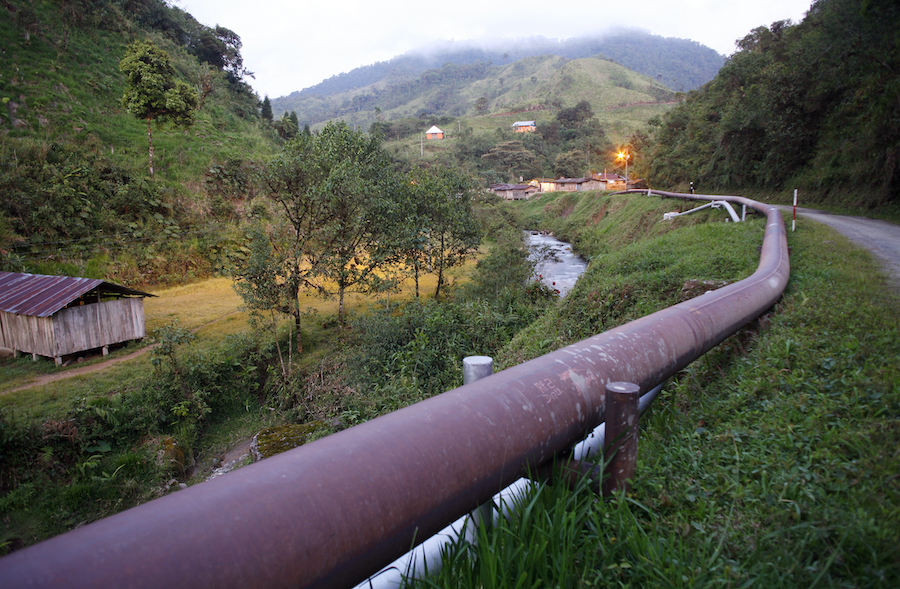ByJuan Martinez
March 2, 2023
Ecuador resumed pumping oil through the Trans-Ecuadorian Oil Pipeline System (SOTE), the largest state-owned oil pipeline, after seven days paralyzed due to a bridge collapse in the province of Napo (center) said yesterday, Wednesday, the public company EP Petroecuador.
The entity said in a statement that “since 19:20 (local time) on Tuesday, the start-up process for pumping crude oil through the SOTE began after the completion of the preventive and securing works of this transport infrastructure”.
Last Feb. 22, EP Petroecuador preventively suspended SOTE operations due to the breakage of the bridge over the Marker river in Napo, where part of the oil infrastructure of this pipeline is located.

Trans-Ecuadorian Oil Pipeline System (SOTE). (Photo internet reproduction)
According to the authorities, the bridge’s collapse and soil instability is a consequence of natural regressive erosion in the area.
The general manager of EP Petroecuador, María Soledispa, quoted in the communiqué, indicated that currently, the SOTE, about 500 kilometers in length and essential for the transport of crude oil extracted in the Amazon, is pumping 13,750 barrels of oil per hour.
He also announced that in the next few hours, it is expected to progressively restart operations in the wells located in the oil fields in the Amazon region of the country, which were shut down on Feb. 24 after the suspension of the SOTE, as well as another private oil pipeline and a poly-pipeline.
The emergency caused by the bridge’s collapse over the Marker river also led to the preventive suspension of crude oil pumping through the private OCP Heavy Crude Oil Pipeline (operated by OCP Ecuador S.A.) and of fuel through the Shushufindi-Quito Polyduct.
Due to this, EP Petroecuador declared “Force Majeure” in the oil sector, a legal figure that avoids sanctions on the state-owned oil company by foreign contractors to which it sells hydrocarbons.
In the case of the Shushufindi-Quito Polyduct, EP Petroecuador stated that work continues to secure its pipeline, which will be located under the SOTE to take advantage of the infrastructure already installed.
“These works have an advance of more than 40 percent, and it is expected to resume operations and fuel pumping as of this Friday, Mar. 3,” the company said in the statement.
It added that once these preventive tasks are completed, the eighth variant of the SOTE and the sixth variant of the Poliducto will be built on the mountain to ensure continuity in operations and prevent them from being affected by situations related to the increase in the flow of the Marker river.
According to Petroecuador, oil is Ecuador’s main export product, producing around 500,000 barrels of crude per day.
According to the authorities, the bridge’s collapse and soil instability is a consequence of natural regressive erosion in the area.
The general manager of EP Petroecuador, María Soledispa, quoted in the communiqué, indicated that currently, the SOTE, about 500 kilometers in length and essential for the transport of crude oil extracted in the Amazon, is pumping 13,750 barrels of oil per hour.
He also announced that in the next few hours, it is expected to progressively restart operations in the wells located in the oil fields in the Amazon region of the country, which were shut down on Feb. 24 after the suspension of the SOTE, as well as another private oil pipeline and a poly-pipeline.
The emergency caused by the bridge’s collapse over the Marker river also led to the preventive suspension of crude oil pumping through the private OCP Heavy Crude Oil Pipeline (operated by OCP Ecuador S.A.) and of fuel through the Shushufindi-Quito Polyduct.
Due to this, EP Petroecuador declared “Force Majeure” in the oil sector, a legal figure that avoids sanctions on the state-owned oil company by foreign contractors to which it sells hydrocarbons.
In the case of the Shushufindi-Quito Polyduct, EP Petroecuador stated that work continues to secure its pipeline, which will be located under the SOTE to take advantage of the infrastructure already installed.
“These works have an advance of more than 40 percent, and it is expected to resume operations and fuel pumping as of this Friday, Mar. 3,” the company said in the statement.
It added that once these preventive tasks are completed, the eighth variant of the SOTE and the sixth variant of the Poliducto will be built on the mountain to ensure continuity in operations and prevent them from being affected by situations related to the increase in the flow of the Marker river.
According to Petroecuador, oil is Ecuador’s main export product, producing around 500,000 barrels of crude per day.
No comments:
Post a Comment